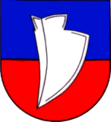Dolní Lhota u Ostravy
| Dolní Lhota | ||||
|---|---|---|---|---|
|
||||
| Basic data | ||||
| State : |
|
|||
| Region : | Moravskoslezský kraj | |||
| District : | Ostrava-město | |||
| Area : | 536 ha | |||
| Geographic location : | 49 ° 51 ' N , 18 ° 5' E | |||
| Height: | 292 m nm | |||
| Residents : | 1,485 (Jan 1, 2019) | |||
| Postal code : | 747 66 | |||
| License plate : | T | |||
| traffic | ||||
| Street: | Velká Polom - Zbyslavice | |||
| Railway connection: | Vřesinská – Zátiší ( regional tram) | |||
| Next international airport : | Ostrava Airport | |||
| structure | ||||
| Status: | local community | |||
| Districts: | 1 | |||
| administration | ||||
| Mayor : | Jan Exner (as of 2008) | |||
| Address: | Poštovní 250 747 66 Dolní Lhota |
|||
| Municipality number: | 506711 | |||
| Website : | www.dolnilhota.cz | |||
Dolní Lhota (German Klein Ellgoth ) is a municipality in the Czech Republic . It is located 14 kilometers west of the city center of Ostrava and belongs to the Okres Ostrava-město .
geography
Dolní Lhota extends in the Lower Jeseníky valley on the left over the Porůbka valley. The Opustna stream flows to the east. The overland tram runs along the Porůbka from Ostrava -Vřesinská to Zátiší.
Neighboring towns are Mlýnek and Velká Polom in the north, Nová Plesná in the northeast, Krásné Pole and Hlubočice in the east, Nová Plzeň and Vřesina in the southeast, Čavisov in the south, Kyjovice in the southwest, Zátiší, Zálučí and Horní Lhota in the west and Josefovice in the north-west.
history
The first written mention of a farm Lhotka Důlní , which at that time belonged to Heinrich von Bítov ( Jindřich z Bětova also z Bítova ), took place in 1377. Since 1424 the existence of the village Lhotka can be proven. In 1464 the village was also called Lhotka Důlní or Nieder Ellgoth . The following year the brothers Žibřid and Nikolaus Donat bought the village on Velká Polom. 1486 acquired the prashma of Bilkau Lhotka Důlní . Since 1514 the place was called Malá Lhota or Klein Ellgoth . Under the Count Vlček von Dobrá Zemice , Ober Ellgoth was added to the Koenigsberg rule at the end of the 17th century and remained subject to it until the patrimonial rule was abolished.
From 1850 on, Klein Ellgoth / Malá Lhota formed a community in the Opava district . In 1896 the village was assigned to the Wagstadt district . The owners of the Klein Ellgoth estates were Count Wilczek until 1918. In 1924 the name of the municipality was changed to Dolní Lhota . In 1926, the local railway from Svinov to Kyjovice-Budišovice began operating in the Porůbka valley , where Dolní Lhota received a train station. 715 people lived in the village in 1930, 732 in 1939.
As a result of the Munich Agreement , Dolní Lhota was added to the German Reich on October 1, 1938 and until 1945 belonged to the Wagstadt district as Klein Ellgoth . In 1945 during the Moravian Ostrava operation there was heavy fighting with around 500 casualties, including 17 residents of the village. On April 26, 1945, the Red Army took the place. After the Second World War, Dolní Lhota came back to Czechoslovakia.
In the course of the territorial reform of 1960, the Okres Bílovec was dissolved. Dolní Lhota came to Okres Opava at the beginning of 1961 and was united with Čavisov to form a municipality Lhota-Čavisov. In 1969 Čavisov and Dolní Lhota separated again.
Since January 1st 2007 the municipality belongs to the Okres Ostrava-město .
Local division
No districts are designated for the municipality of Dolní Lhota.
Culture
The alternative music festival "Dolnolhotský boys" has been held in the village every year since 1998.
Attractions
- Chapel in the center of the village
- Chapel of St. Cyril and Methodius, consecrated in 2004
- Memorial stone and grave of nine fallen soldiers of the 1st Czechoslovak Armored Brigade
Individual evidence
- ↑ Český statistický úřad - The population of the Czech municipalities as of January 1, 2019 (PDF; 7.4 MiB)


